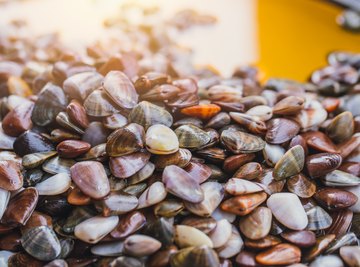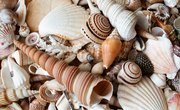
Collecting seashells at the shore is an age-old vacation pastime. Some people bring home their collections to display as decorations or to use for crafts. Vinegar is useful for cleaning and coloring them. However, the acidic liquid can also dissolve seashells when allowed to remain in contact for an extended period.
TL;DR (Too Long; Didn't Read)
The acetic acid in vinegar dissolves the calcium carbonate in seashells. This fact make vinegar useful for cleaning and dyeing seashells.
Seashells Are Mostly Calcium Carbonate
Seashells are the exoskeletons of sea animals known as mollusks. They are composed primarily of calcium carbonate, which is also the main ingredient in limestone. The animals use the shells as their covering until they outgrow them. When that happens they vacate the shells, which may wash ashore.
Vinegar Dissolves Calcium Carbonate
When you soak seashells in vinegar, carbon dioxide bubbles start to form. They are a product of the reaction between the calcium carbonate in the seashell and the acetic acid in vinegar. The reaction has a cleansing effect over a period of several minutes, but eventually, the shell will start to dissolve. It usually takes a few days for the shell to dissolve completely. Before that, it will get progressively thinner and more fragile.
Cleaning with Vinegar
If you want to clean a seashell, it's better to scrub with vinegar than it is to allow the seashell to soak. Washing the inside of the shell with vinegar, followed by a combination of warm soap and water, will help to remove debris and may help neutralize the odor that often accompanies seashells. As an alternative to using vinegar, you can also boil seashells in salt water to help remove bacteria and odor.
Vinegar Also Makes Dyeing Easier
Some crafters choose to color or dye seashells to create a different look. Vinegar can assist in the process by etching the surface of shells so the dye penetrates into the pores. When coloring shells, mix vinegar with hot water and food coloring or a mixture from an egg-coloring kit. Use only a drop of vinegar to avoid dissolving the shell when it soaks in the mixture.
